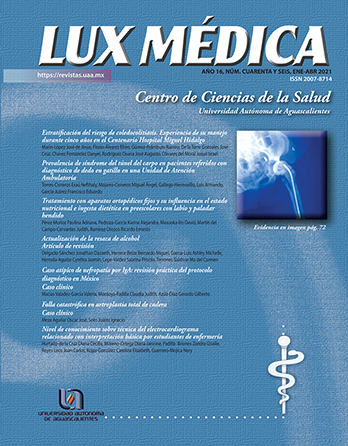Choledocholithiasis risk stratification. Five years of treatment experience at Centenario Hospital Miguel Hidalgo
DOI:
https://doi.org/10.33064/46lm20213058Keywords:
choledocholithiasis, ERCP, bile duct exploration, post-ERCP pancreatitisAbstract
Introduction: choledocholithiasis develops in 8% to 18% of patients with lithiasic cholecystitis. Diagnosis is based on the criteria of the American Society for Gastrointestinal Endoscopy (ASGE). In patients with highrisk, the suggested treatment is endoscopic retrograde cholangiopancreatography (ERCP), although surgical bile duct exploration (BDE) has shown similar results in terms of effectiveness and complications. There is still controversy regarding the best treatment option. Objective: to analyze and describe our experience in managing patients with high-risk of choledocholithia-sis at Centenario Hospital Miguel Hidalgo over five years. Methods: this is a retrospective, descriptive, analytical, and comparative case series study of patients at highrisk of choledocholithiasis. Two groups were generated based on treatment: endoscopic retro-grade cholangiopancreatography (ERCP) or bile duct exploration (BDE). Description of qualitative and quantitative variables with percentages and measures of central tendency, chisquare for categorical variables, Student’s t, or U Mann-Whitney according to data normality. Results: 76 patients with a high-risk of choledocholithiasis were included, 55 (72.37%) female and 21 (27.63%) males. The average age was 43 years (SD ± 19.07). ERCP was therapeutic in 41 cases (56.94%), non-therapeutic in 31 (non-patent bile duct, n = 20; absence of stone, n = 11), and ERCP was not performed in 4 cases. Twenty-four patients with BDE were treated, 95% were solved. There was no association between type of approach and complications (p = 0.823). Post-ERCP pancreatitis was found in 18.42%. Hospital stay with ERCP was 9 days (± 12, 2-87) and with BDE 8 ± 5 days (2-21). Conclusions: BDE is the procedure with the most cases solved in our institution. Deciding the treatment strategy will depend on the experience and supplies in each ins-titution.
Downloads
Downloads
Published
How to Cite
Issue
Section
License
La revista Lux Médica está bajo una licencia de Creative Commons Reconocimiento-NoComercial-Compartir Igual 4.0 Internacional.












